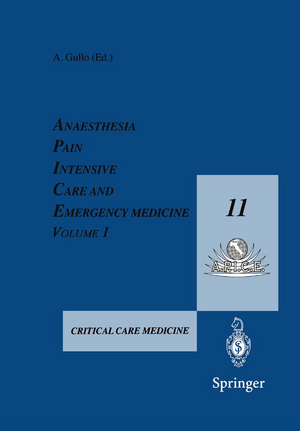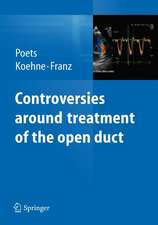Anaesthesia, Pain, Intensive Care and Emergency Medicine — A.P.I.C.E.: Proceedings of the 11th Postgraduate Course in Critical Care Medicine Trieste, Italy — November 11–16, 1996
Editat de Antonio Gulloen Limba Engleză Paperback – 31 oct 1996
| Toate formatele și edițiile | Preț | Express |
|---|---|---|
| Paperback (2) | 413.90 lei 6-8 săpt. | |
| Springer – 31 oct 1996 | 413.90 lei 6-8 săpt. | |
| Springer – 31 oct 1995 | 418.09 lei 6-8 săpt. |
Preț: 413.90 lei
Preț vechi: 435.69 lei
-5% Nou
Puncte Express: 621
Preț estimativ în valută:
79.20€ • 82.91$ • 65.53£
79.20€ • 82.91$ • 65.53£
Carte tipărită la comandă
Livrare economică 05-19 aprilie
Preluare comenzi: 021 569.72.76
Specificații
ISBN-13: 9783540750321
ISBN-10: 3540750320
Pagini: 984
Ilustrații: V, 983 p.
Dimensiuni: 170 x 244 mm
Greutate: 1.54 kg
Ediția:1997
Editura: Springer
Colecția Springer
Locul publicării:Milano, Italy
ISBN-10: 3540750320
Pagini: 984
Ilustrații: V, 983 p.
Dimensiuni: 170 x 244 mm
Greutate: 1.54 kg
Ediția:1997
Editura: Springer
Colecția Springer
Locul publicării:Milano, Italy
Descriere
At the APICE '96 research scientists and clinicians were provided with updated guidelines for the treatment of patients with acute and chronic critical conditions. This volume contains 100 chapters,in which the main pathophysiological concepts were reviewed, with special emphasis on the cardiovascular, respiratory, metabolic, and neurologic systems. Special reference is made to the pharmacologic and biotechnologic strategies currently being used to support those vital functions that are affected by severe and sometimes devastating diseases. The topics of infection, sepsis,and SIRS have been reviewed and updated in keeping with the most recent information available, and particular focus has been directed to ethics.
Cuprins
Preliminary Report of Clinical Xenon (XE) Anaesthesia and Xenon Recycling System.- Biochemistry of Neurotransmission: an Update.- Continuous Measurement of the Systolic Time Intervals Integrated on a Hemodynamic Profile. Successful Method to Monitor Left Ventricular Function.- Relationship Between the PetC02 and the Hemodynamic Parameter.- Oxygen Transport and Cellular Mechanisms during Hyperbaric Oxygenation.- Hyperosmolar Syndrome.- Basic Components of Immune System Regulation.- Growth Hormone in Critical Care Practice.- Oxygen Consumption and Carbon Dioxide Production: Physiological Basis and Practical Application in Intensive Care.- Clinical Aspects of Capnography.- Capnography and Circulation.- Pain Control: From Basic Research to Clinical Application.- Theoretical Aspects of Respiratory Mechanics.- The Effect of Age on the Cardiovascular Response to Stress.- Heart Failure Due to Pressure Overload and Volume Overload.- Choice of Pharmacological Agents in Hypoperfusion Syndrome.- Monitoring of the Body Circulation — an Introduction.- Evaluation of Cardiothoracic Parameters: The Clinical Role of Intrathoracic Blood Volume.- ARDS Lung: Homogeneous or Non-Homogeneous Impairment?.- The Baby Lung Philosophy.- Lung Distention, Barotrauma and Mechanical Ventilation.- Pulmonary Dysfunction after Ischemia-Reperfusion.- Understanding the Incidence and Long-term Outcome of ARDS.- Improved Perfusion Through the Aerated Part of the Lung by Prostacyclin Administration.- Improving Ventilation by Reaeration of Atelectatic Regions with Perfluorocarbons.- Experience in Liquid Ventilation.- Improved Ventilation by Re-aeration of Atelectatic Regions with Exogenous Surfactant in Acute Respiratory Failure.- Combining Exogenous Surfactant or Perfluorocarbons with Inhaled Nitric Oxide to Improve Lung Function in Acute Respiratory Failure.- Functional Aspects of Noninvasive Ventilation.- Face Mask Ventilation in Decompensated COPD Patients.- Methodology of Noninvasive Positive Pressure Ventilation in Acute Respiratory Failure.- Mask Ventilation for Trauma Patients with Acute Respiratory Failure.- Acute Respiratory Failure in Immunocompromised Patients: A Possible Indication for Non-Invasive Ventilation.- Assessment of Respiratory Dysfunction in Children with Acute Respiratory Distress Syndrome.- Recent Therapeutic Strategies for Children with Acute Respiratory Distress Syndrome.- Humoral Homeostasis — Role of Vascular Endothelium.- Mortality in Sepsis.- Guidelines on Antibiotic Combination in ICU Patients.- Clinical Neurological Approach at the Bedside: The Method in Neurology and Its Application to the Critically Ill Patient.- Assessment of Cerebral Dysfunction.- Myasthenia Gravis.- New Trends in the Treatment of Advanced Neurological Disease Condition — Guillain-Barré Syndrome.- Continuous Filtration of Cerebrospinal Fluid (CSF-Filtration) in Fulminant Bacterial Meningitis — A New Adjuvant Therapeutic Strategy?.- Prevention and Treatment of Acute Renal Failure — Timing in the Use of Dialysis.- The Hepatorenal Syndrome.- The Impact of Continuous Venovenous Hemofiltration in Nonoliguric Septic Patients.- Plasmapheresis in Acute Critical Conditions.- Modern Treatment and Monitoring of Haemorrhagic Shock.- Use of Erythropoietin in Critically Ill Patients.- The Treatment of Acute Pancreatitis.- Standards of Treatment of ICU Patients — Treatment of Head Injured Patients.- Treatment of Patients after Lung Surgery.- How to Manage Pulmonary Contusion.- Preoperative Clinical Evaluation.- Hypnosis.- Pharmacological Basics of Clinical Anaesthesia: Analgesia.- Myoresolution.- Neurovegetative Stabilization during Clinical Anaesthesia.- Guidelines on Postoperative Care.- Fast Track Anaesthesia.- Antifibrinolytic Therapy in Cardiac Surgery.- Respiratory Function after Cardiac Surgery.- Endomyocardial Revascularization.- Cardiac Transplantation or Ventriculectomy?.- Anaesthesia in Geriatric Patients.- Awareness during Anaesthesia.- Early Adverse Effects in the Postoperative Period.- Locoregional Anaesthesia in High Risk Patients.- Computer at the Bedside: Recording the Anaesthesiological Process.- The Modem and the Remote Control of Anaesthesiologic Activity.- Anaesthesiology on Internet.- Hypertension.- Diseases during Pregnancy: Epilepsy.- Cardiac Disease in Pregnancy.- Uncommon Diseases during Pregnancy.- Organization of Postoperative Pain Service.- Patient-Controlled Analgesia in Obstetrics and Pain Management.- Epidural Versus Spinal Analgesia.- Management of the Postoperative Pain.- Acute Pain and Other Aspects of the Postoperative Period.- Pharmacological Combinations and Techniques in the Acute and Chronic Benign Pain.- Guidelines on Cancer Pain Treatment.- Palliative Care — Basics and Guidelines.- Cardiac Tamponade: Diagnosis and Treatment.- Key Points in the Treatment of Cardiac Arrest.- Myocardial Dysfunction Following Successful Cardiac Resuscitation.- The CPR Continuing Education Programme and Its Goals.- Anaesthesia and Intensive Care in Difficult Situations.- Education and Training in Anaesthesia — A Plea for One Standard in Europe.- Education and Training in Intensive Care.- Postgraduate Training in Disaster Medicine.- Medical Decision Making in Critical Care — The Patient as a Person.

















